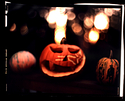OK, I did a little more sleuthing, and it seems the DPII has been replaced in this country with PDN, which likewise is a lower-contrast CAII
paper marketed for automated printers, but no longer specifying a special developer for enhanced blacks. The dye curves as well as the tech
sheet shows that improvement. Otherwise, it's basically a portrait paper with less snap than the dual-exposure regular CAII or its predecessor,
Super C. So in analog printing, you'd need to increase contrast via added masking, for such subjects where this is warranted. It also looks like
its risk of crossover is also minimized. On this topic, is is not only older design colorheads which can be a problem, but any that have been
so heavily used, or repeatedly overheated, that the dichroic filters start spalling and passing too much white light, and are due for replacement. Ironically, this happens most often on very expensive high-output enlargers which basically nuke the negs. Certain color mural
enlargers, for example, would need filter replacement every six months when heavily used. That might sound insane to those of us who print
at home, but I did own one of those beast at one time, and the cooling fan alone drove up my electric bill more than the rest of the whole
building, not to mention the lamps.





